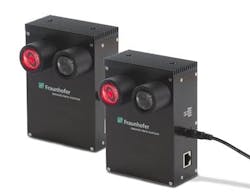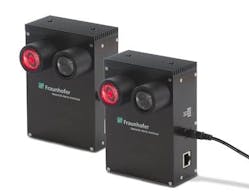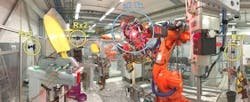Meanwhile, more details emerge on why the automaker used infrared rather than visible light in its trial: It’s faster.
After BMW’s successful trial of Li-Fi on the factory floor, the automaker has told LEDs Magazine that the system would require miniaturization prior to any full-on deployment. At the same time, it has become clearer why BMW used infrared light rather than visible: Infrared is faster, according to the group that led the project.
Interested in articles & announcements on Li-Fi and smart lighting technology?
For a quick refresher, Li-Fi is a long-emerging wireless technology that sends and receives data via LED light. It is like Wi-Fi, but it uses light frequencies rather than radio waves. Developers say it augurs a huge increase in spectrum availability for Internet service, where the radio spectrum is saturating. Wi-Fi radio signals often clash with each other, and are prone to electromagnetic interference, especially in a factory setting.
Li-Fi can use the visible light emitted by LED luminaires, or, as at the Munich BMW plant, it can use infrared light, an invisible portion of the light spectrum.
BMW had been testing Li-Fi to transmit information to and from a single factory floor robot used to inspect automobile bodies, in a small trial led by Berlin’s Fraunhofer Heinrich Hertz Institute. As LEDs recently reported, Fraunhofer last month announced that the trial had shown that the concept works, but it rated the technology’s “readiness level” at 6 out of 9, noting that 9 would be necessary for general deployment.
These proof-of-concept infrared Li-Fi transceivers (top) did the job on the BMW factory floor (bottom), where they were mounted on the inspection robot and the perimeter fence. But the automaker hopes for smaller models prior to any general deployment.
More details have now emerged from BMW on what still needs to be done.
BMW project manager Gerhard Kleinpeter told LEDs that while “some important functionalities such as data transfer rate, stability, and low delay have been proven in the project, the technology must still be further developed for possible use in the production field — in particular, a significant miniaturization of the systems is required.”
Specifically, Kleinpeter said the infrared transceivers mounted on the robot and on the clear perimeter wall that cordons off the approximate 16 × 16-ft robotic area were too large, noting they need to be around the size of a USB stick. The 14 transceivers that Fraunhofer used in the trial were around the size of an external hard disk drive, at 87 × 114 × 42 mm (around 3.4 × 4.5 × 1.6 in.), mounting six on the robot and eight on the wall. The wall transceivers were wired to each other and into BMW data servers.
When Fraunhofer first started the trial about three years ago, it had intended to use visible light, not infrared, to deliver the downlink.
But infrared provides certain advantages over visible light. Chief among them: It’s faster, because the frequency modulation that is at the heart of how Li-Fi embeds data is quicker than it is in visible white light, which typically uses a phosphor layer over a blue LED chip.
“When you have a single-color LED, you have all the modulation available — the light is modulated, and you have the whole dynamic,” explained Anagnostis Paraskevopoulos, Fraunhofer’s Li-Fi project manager. The same is true when white light comes from an RGB LED light source.
But modulation slows down noticeably in the common method of delivering white light from a blue diode emitting through a yellow phosphor layer.
“When you have a blue chip emitting through a phosphor layer, you’re losing part of the modulation,” Paraskevopoulos said. “From a modulation point of view, this is a very slow layer, the phosphor layer. White light for high speed is the worst choice. It’s nice when you want to combine Li-Fi with illumination. But from a technical [data transmission] point of view, we would certainly prefer a single-colored LED.”
The uplink portion of the BMW system — the communication from the inspection robot back to the fence-mounted transceivers — was also infrared, which is common even in visible light downlink systems, as white light at desktop and eye levels would be too distracting.
The system operated at 100 Mbit/s in both directions, said Fraunhofer’s BMW project coordinator Volker Jungnickel.
The BMW trial echoed a data-only Li-Fi approach taken by Fraunhofer HHI on a new infrared Li-Fi transmission box for outdoor data communications, in collaboration with Japanese telecommunications company Sangikyo. Fraunhofer is also working with visible light systems, such as at a high school in Stuttgart.
Meanwhile, while BMW sees potential in Li-Fi as a means to free up wireless spectrum and circumvent the limitations of Wi-Fi, it does not seem in a rush to deploy a factory Li-Fi system for real.
“We are dependent on suppliers which can provide the hardware with the usual availability and support,” Kleinpeter said in response to an LEDs question on the carmaker’s plans for Li-Fi. “Only then, after appropriate system tests, will we think about possible or specific usage scenarios in our production lines. I don’t want to speculate at this time about any applications.”
The issue of miniaturization will be a familiar one to developers of visible light Li-Fi. One of the things holding back Li-Fi as a general means for Internet service is that gadget and laptop vendors have yet to embed circuitry that would support Li-Fi, the way they’ve been doing with Wi-Fi for many years.
One Li-Fi company, Edinburgh, Scotland-based pureLiFi, last fall announced it had reduced circuits to dimensions small enough to fit inside gadgets and laptops. But until gadget makers decide to build them into their products, pureLiFi continues to offer them in “dongle” form.
MARK HALPERis a contributing editor for LEDs Magazine, and an energy, technology, and business journalist ([email protected]).







